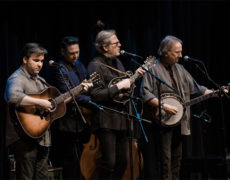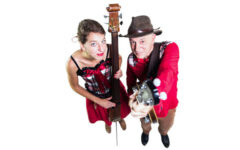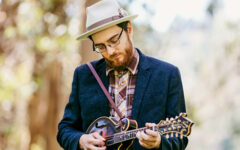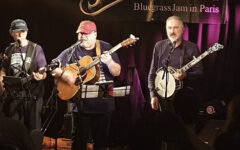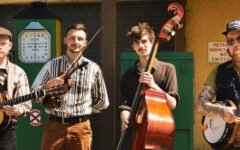
There may be no more prolific or proficient musician in the combined history of bluegrass, country music, grassicana, or Americana than multi-instrumentalist Herb Pedersen. As the founder and helmsman of several significant combos, as well as a sideman to such stars as John Denver, David Grisman, Jackson Browne, Dan Fogelberg, Kris Kristofferson, Linda Ronstadt, Emmylou Harris, John Prine, Gordon Lightfoot, Peter Rowan, Country Gazette, Michael Martin Murphy, and so many more, Pedersen long since earned his reputation as one of the most in-demand musicians of the modern era.
Lest one get the impression that Pedersen’s career has been spent entirely in service to others, it’s well worth remembering that he’s also an innovator in his own right. A prime member of the Desert Rose Band and a perennial partner of its erstwhile leader, Chris Hillman, he’s also the founder of LA’s Laurel Canton Ramblers and a graduate of such esteemed combos as the Dillards, David Grisman’s Smokey Grass Boys, and Old & In the Way.
These days, Pedersen is touting a new band that has him involved — a group called the Saints that also includes singer, songwriter and guitarist Mike Beck, Mark Fain on electric bass, pedal steel player Steve Hinson, and drummer Pete DeCoste. The group’s new EP, Tassaljara Road, recalls the sun-drenched sound of Southern California circa the early ‘70s, a prime period for the nascent country rock revival.
After being greeted with some well-deserved praise from yours truly, Pedersen showed his modesty was as evident as his abilities. “I don’t know how to respond to that,” he replied in response to the onslaught of praise and plaudits. “What I usually do is simply move on to the next project, so to speak. I don’t dwell on the past all that much. I’ve been very fortunate, and I do have some fond memories.”
Pedersen admits he that he occasionally falls prey to nostalgia, but he’s mainly focused on what’s next. He says simply that he’s been lucky.
Clearly, luck has little to do with it however, although in the case of the Saints, he was fortunate to fall in with Beck, who he met backstage before a Hillman-Pedersen gig.
“Mike gave me one of his albums, and I took it home and listened to it,” Pedersen recalls. “The first tune I wasn’t that fond of, but the second one got me, and all the way through I was really infatuated with all he had done. So I responded to him, and we kept in touch. I told him that I’d love to take him into the studio and record some of his songs. He said, ‘That would be great!’ We got Mark on bass, who had worked with Ricky Skaggs for 17 years, and my friend Pete DeCoste on drums, who’s a really solid guy, and Steve Hinson on pedal steel, who worked with George Jones and a lot of people out of Nashville. So we put that together and went to Nashville with five songs. We’re at the point now where we’re simply trying to get the music out there.
Pedersen said the band will tour if all goes well initially.
Nevertheless, Pedersen hasn’t turned his back on bluegrass, and he cites a project he launched with another Desert Rose Band alumnus, John Jorgenson, dubbed J2B2. The band recorded an album of their own and also tours at least once a year. Pedersen says the band keeps him in touch with his bluegrass roots, a genre he still feels affection for.
“It’s been productive,” he says of his career. Even at age 75, Pedersen says that making music is still of prime interest.
“I was talking to Tom Petty on a plane during the Mudcrutch tour I was on, and he asked me, ‘What would be your plan B?” he remembers. “I said, ‘I don’t really think I’ve ever had a plan B.’ And he said, ‘Those are the kind of people I really like, the guys who don’t have any choice when it comes to making music. That’s what their job is. Music is first and foremost and it always will be.’ Music grabs hold of you and won’t let go.”
Indeed, it hasn’t let go of Pedersen, given a career that stretches back nearly 60 years, beginning with his first band, the Pine Valley Boys, which he joined at age 17 while he was still in high school. He moved to Nashville in 1967, then back to L.A. where he fell in with Linda Ronstadt’s backing band and was given opportunity to play on some of her seminal solo albums. Word of mouth quickly followed, and he soon found himself in an exclusive circle of on-call session players for the Laurel Canyon elite.
“It was very exciting,” Pedersen says, reflecting back on the experience. “You often wonder as a young person, ‘Can I really do this?’ But I had a lot of support from a lot of people. That question occasionally entered my mind, but I always felt like I was on the right track.”
Pedersen says that the Everly Brothers’ harmonies swayed him early on, and that from there, it folk music that drew him in. Bluegrass beckoned thereafter. “It was a natural progression,” he adds in retrospect. “Harmony was always really important to me. And then in the Dillards, we wrote our own material, so that was a great learning experience as well. It was a one thing leading to another kind of thing.”
It may seem surprising that over the course of his career, Pedersen’s only released three albums under his own aegis — Southwest (1976), Sandman (1977) and Lonesome Feeling (1984). That’s a somewhat scant solo output for a musician as prolific as Pedersen.
“I guess it’s been due to lack of confidence in my songwriting, my lead singing and all that,” he muses. “I’ve always been a team player, and that’s always been a comfortable role for me. Now with Chris Hillman, with whom I’ve worked as a duet for a long, long time, I sing some of the songs I’ve written. So there’s a bit of the spotlight there. I just feel more comfortable working with other people. I never felt that strong as far as my own lead singing is concerned.”
Bluegrass fans might argue with that contention, celebrating his songwriting in his contribution of Wait A Minute, a classic recorded by Seldom Scene in 1974.
Nevertheless, Pedersen found himself at a crucial crux as far as the evolution of rock and country’s crossover.
“When I was in the Dillards, we were playing in Fort Worth once, and Don Henley, who’s still a good friend of mine, came to see us play. He was still in high school. We had a wonderful conversation. He was in a group called the Shilohs, and I remember him asking Rodney Dillard, ‘What are the chances for a group like ours to go out there and do this kind of thing?’ And Rodney answered, ‘Well, that’s where you ought to be right now if you’re going to do this.’ Southern California was very experimental back then, because you had a lot of places you could play, like the Palomino, the Golden Bear, and other venues around town. People would come in the back door and take a slot and play one song, or maybe two. It was an earn while you learn kind of thing. It was great to witness that breed of young singer/songwriters as they developed their craft in front of an audience. You don’t see much of that anymore.”
Nevertheless, in the mid ‘60s, the rock crowd and the country crowd were strictly segmented. Each was wary of the other and that made the fusion of the two styles seem even more auspicious.
“The Palomino was one of those places where we kind of split the atom as far as country and rock and roll,” Pedersen suggests. “We were coexisting. We played there with Linda Ronstadt. People loved her singing, but there was a real rock element to what she was doing too. It was kind of a cool place where Keith Richard might come in and hang with the band. It had a great mix of country, bluegrass, and rock and roll, and it all worked.”
Pedersen credits Buck Owens, Merle Haggard, the Dillards, Dillard and Clark (the “Clark” being Gene Clark, past and future member of the Byrds), Buffalo Springfield, Poco, and the Nitty Gritty Dirt Band with furthering that crossover concept. “I don’t know that we were aware of the long view of what it might become,” he reflects. “We were just picking the tunes and adding our interpretation musically of what it should sound like. The Dillards took a song like the Beatles’ I’ve Just Seen A Face and turned it into a bluegrass tune. The Osborne Brothers did the same thing with Yesterday’s Gone by turning it into a bluegrass tune.”
So was it kind of like a wow moment, we wondered?
“Well, kind of,” Pedersen says. “We had our moments, and I’m sure that’s true today for a lot of people. Chris is very critical of his own songwriting and there are songs he won’t even play for me. But you have to be that way.”
Pedersen cites bands like Nickel Creek’s Sean and Sara Watkins, Béla Fleck, and the Punch Brothers as among today’s more astute musicians. “Bluegrass audiences are very loyal to the bands they like,” he suggests. “If you stray too far from center, you’re going to lose some of that audience.”
Thankfully then, even with his versatility, that’s one thing that’s never given Pedersen reason to worry.

